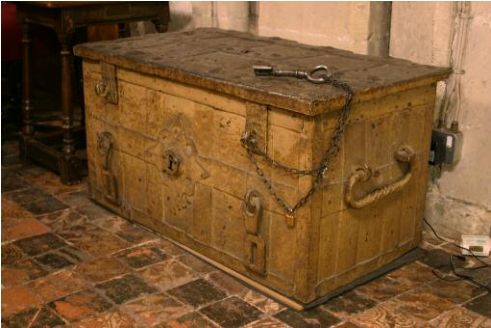Financial record-keeping at Canterbury Cathedral in the late 17th century

At the St Katherine’s Audit each November in the late seventeenth century, the Dean and Chapter drew up an account of the Cathedral’s wealth in a single sheet document headed ‘The State of the Church’. The Cathedral Archives has a continuous series of these records from 1679 to 1712 (DCc/SC1-32; 1680 is missing).
Each of the annual statements has a similar structure. First of all, the amounts available from the year’s income are listed; the account for 1679 starts:
The Church Stock in 2 Baggs 200 – 00 – 0
Item The late Ld of Canterb. Legacy in one Bagg 100 – 00 – 0
High way money in 3 Baggs 300 – 00 – 0
More in another Bagg 018 – 12 – 0
More, the high-way money of this year 040 – 00 – 0
———————
Sum 658 – 12 – 0
The figure of £200 for the Church Stock occurs every year; it appears to be a fixed sum made available from the reserves. The bequest of £100 from Archbishop Gilbert Sheldon, who died in 1677, is a one-off entry for this year; there are occasional similar one-off sums for gifts in some of the later years. The highway money is also recorded every year and presumably represents revenue from tolls owned by the Dean and Chapter. Expenditure on road repairs at Harbledown is also recorded, for example on 19th April 1687:
Taken out of ye Chest a bagg of Seuenty Seuen pounds eight shillings towards ye repair of Harbledowne highway according to order by me.
signed by the Treasurer, Jean Maximilien de L’Angle (DCc/SC6). Other transactions regularly recorded are for the stipends of the prebendaries and for the salaries of the ‘Quire’.
All of these sums relate to monies paid into or taken out of the central reserves. The 1679 figures record:
Borrowed out of the Chest & deliuered to the Treasurer,
Imp[rimi]s to pay the Midsum[m]er Stipends to ye Deane & Prebends: 195 – 01 – 8
The Treasurer was then responsible for making the individual payments which would be recorded in the Treasurers’ Books and signed for by each of the canons (DCc/TB series). All of these transactions were for large or relatively large amounts of money for payments which could not be made out of current cash-in-hand, or for surplus amounts of cash-in-hand which needed to be put into the reserves. It is clear from the many references in these documents to ‘the Chest’ that there was a central secure repository for the Dean and Chapter’s reserve funds. Many of the transactions are backed up by three signatures, usually of the Dean, the Vice-Dean and the Treasurer, sometimes mentioning that one of the signatories was representing an absent key holder and was armed with his key; for example, in 1688, we find the signature of ‘Geo Thorp cum clave vicede[cani]’ (George Thorpe with the Vice-Dean’s key); Dr Thorpe is signing on behalf of that year’s Vice-Dean whose key he has been given.
This suggests that there must have been a security system involving a chest with three locks which required all three key holders to be present to pay money in or take money out of the reserves. All three then signed a record on the sheet for that year’s ‘State of the Church’ reconciliation for the St Katherine’s Audit. The Chest was already in use in 1662. Dr William Belke, the Treasurer for 1662/1663, records in rough notes at the front of that year’s Treasurer’s Book (DCc/TB 3):
Aug. 25: layd more into ye chest in ye treasury of my money 180£
viz. one bag 100£ and another 80£ in all 480£
Chests of this sort with multiple locks had been a common system for securing institutional valuables since the Middle Ages. An enquiry to the Cathedral’s Vesturer (head virger) Christopher Crooks quickly established that the Cathedral does have such a chest and that it is to be found in the virgers’ office in the Wax Chamber (image above). Mr Crooks informed me that it is thought to be an iron chest of 17th-century German manufacture of a sort (erroneously) known as an ‘Armada’ chest. It seems highly probably that this is the chest referred to in these ‘State of the Church’ documents.
David Shaw
This article originally appeared in the Cathedral Libraries and Archives Association Newsletter, Winter 2016, pp.21–22.